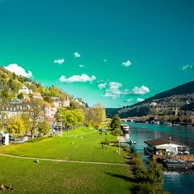Greenhouse gases and climate change: insights into the global carbon cycle using isotope studies
Abstract:
The global mean temperature on Earth has risen by 0.8°C since the 1880s. Man-made emissions of greenhouse gases (GHGs) like CO2, CH4 and N2O are responsible for a large share of this temperature increase. Human-related emissions have led to GHG concentrations unprecedented in the last 800.000 years of Earth history and are altering the natural cycles of those gases significantly. Among the anthropogenically influenced GHGs CO2 is the one with the single largest effect on the Earth's radiation balance. CO2 acts as an exchange molecule in the global carbon cycle, connecting thereby the fast reacting carbon reservoirs atmosphere, biosphere and oceans. The interplay between these reservoirs is highly complex and depends on a multitude of variables, which are last but not least temperature dependent. However, each exchange process between reservoirs leads to small changes in the isotopic composition of the carbon in these reservoirs. Studying the ratios of 13C/12C allows for quantifying the different exchange processes. With the help of the radioactive isotope 14C it is possible to separate and quantify the CO2 originating from the combustion of fossil fuels. This lecture will start out with the basic radiation balance of the Earth and its relation to GHGs, climate and GHG variations in the past as well as the natural budgets of the main anthropogenically influenced GHGs. The main part of the lecture will cover the carbon cycle in detail, using the information embedded in carbon isotope signals. The lecture concludes with present and projected changes in the carbon cycle due to increasing CO2 concentrations and will introduce state-of-the-art carbon cycle observation systems.

